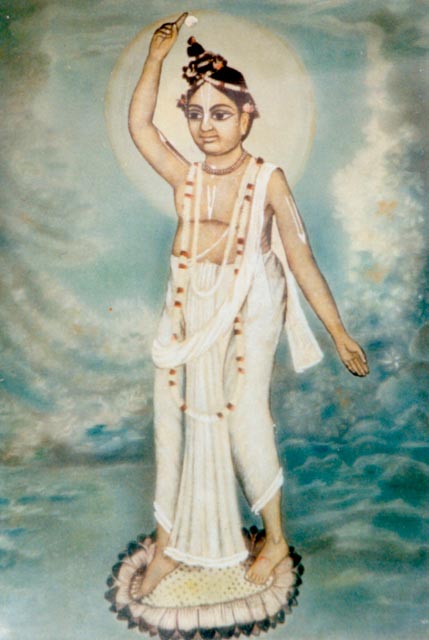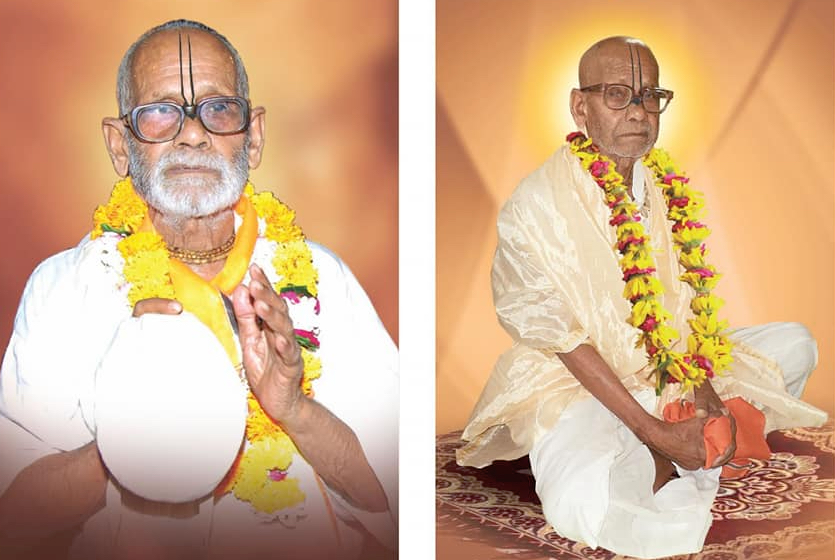Mahanidhi Madan Gopal Das
Between 1950-1965, Pandit Sri Krishna Dasa Babaji Maharaja, Bhakti-tirtha (Radha-Krishna nitya-lila pravista) would often meet with Srila Prabhupada in Bon Maharaja’s college in Vrndavana. The following memories of Pandit Sri Krishna Dasa Babaji come from a book titled, “Our Srila Prabhupada—A Friend to All”, penned by a Srila Prabhupada disciple named Mula-prakrti devi dasi.
May everyone relish the sweet and sometimes humorous exchanges between the liberated ones.
Pandit Sri Krishna Dasa Babaji:
“I was a Sanskrit student and scholar in the early 1960’s in Vrndavana. I was teaching in Bon Maharaja’s Sanskrit college across from ISKCON. At that time, Srila Swami Maharaja also was living in Vrindavana writing English translations and purports to the Srimad Bhagavatam.”
“At the college, some local Gaudiya and Vrajavasi scholars and writers would regularly meet to share their work and ask for suggestions regarding Sanskrit or philosophy. I attended those writers’ meetings and so did Srila Swami Maharaja. That’s how we began our acquaintance and friendship.”
“I remember how delightful Swamiji’s countenance was. He was very charming, full of realization, very humorous and affectionate. He was so kind upon me even though I was a much younger and junior in all ways. Yet Swamiji treated me just like a son or a very little brother. He always encouraged me, asked about my welfare, and shared Hari-katha from his writings.”
“He was a valuable friend during that time. Although his material circumstances were then so poor, he always seemed to me to be one of the richest devotees in spiritual blessings. He was a very learned and humble Vaisnava. He worked very diligently on his manuscripts, and often spoke about the order from his guru maharaja, His Divine Grace Srila Bhaktisiddhanta Sarasvati Thakura Prabhupada.”
“I have one special remembrance of something that occurred during our regular meetings at Bon Maharaja’s college. Swamiji had every intention to somehow spread this Krishna knowledge in the West, despite all obstacles.”
“Prabhupada would often speak of this task of service, and was always looking for opportunities to somehow arrange to travel there. Most of us at that time were quite doubtful that he could succeed to go. He was practically penniless then, without sponsors or connections. Many of us were not so favorable for any Indian to go to the mleccha [western] countries, so we did not encourage him. Nevertheless, he was undaunted.”
“I recall how Swamiji came one day in great happiness and excitement. I think he had just completed his third volume of the Srimad Bhagavatam and he was carrying all three in his hands. He then explained to our group how he had finally printed the last texts and now the books were ready to go to the West.”
“In a very sweet way, he formally asked if we would all please bless his books that they would be able to go across the ocean and be successful in spreading Krishna consciousness in the western countries. Of course, we were willing to do that. So he carefully passed around the stack of three, brick-red, cloth bound books, and asked each of us to touch them and give our blessings, which we did.”
“Immediately after this he did something quite remarkable. Swamiji explained with deep seriousness how these Bhagavata books, now blessed, could not go across the ocean by themselves. Someone would have to take them to the west, popularize them, and distribute them properly to the public. So he then humbly requested, with folded palms, that our assembly would also bless him to accompany the books and preach on their behalf. In this way he took us all by surprise.”
“We all then felt moved to finally give our full blessings to his mission. I thought at that time how remarkable a Vaisnava he was, to request such blessings and to arrange for receiving them so wonderfully. I remember when I gave my blessings to him, I felt a spiritual surcharge in my heart.”
“Many years later, and now still it stands strongly in history how Srila Bhaktivedanta Swami Maharaja [Srila Prabhupada] was successful in carrying our heritage and philosophy to the whole world. I feel honored to have been some very small part of that glorious success.”
Srila Prabhupada ki jai! Pandit Sri Krishna Dasji Babaji Maharaja ki jai!
Sajjana sadhu sanga ki jai! Jaya Jaya Sri Radhe!


